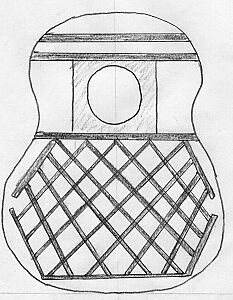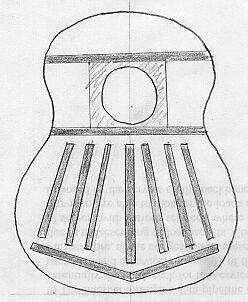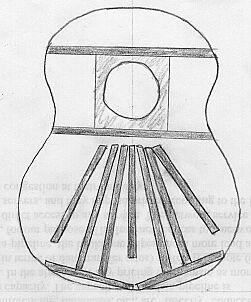Acoustically Important Construction Features
Three main features:
- Coupling
- Material Composition
- Plate Bracing
- Coupling
'Coupling' simply refers to an interaction between two or more vibrating elements. First of all, on a guitar, the string is excited (plucked or picked) by your fingers, vibrating the bridge, which then goes on to vibrate the soundboard and the internal air cavity, then the back and sides and so on. If these these elements interact well, the whole system is said to be strongly coupled.
The body of the guitar acts so that the high pressure vibrations at the bridge are turned into low pressure vibrations of the surrounding air. This is a form of "impedance matching", in much the same way an electrical transformer raises or lowers a potential difference and is the main principle behind speaker cone design.
The higher frequency (pitch) sounds are produced by string interaction with the bridge and then the sound board, whereas the lower frequencies are essentially driven by the internal air cavity/sound hole and ribs/back coupling effects:
The interaction looks roughly like this:

(Low Frequencies)

(High Frequencies)
Schematic of Frequency-dependent Component Oscillations. Arrows show main direction of vibratory interaction. Note that some of these influences act in both directions as mechanical feedback, eg. Bridge vibration affects the string's motion as a secondary influence.
Coupling between parts depends on geometry, sound frequency and the materials used.
Interaction strengths between various components need to be optimised according to taste; a certain amount is needed to radiate the sound transferred from the string's vibration, but too much coupling produces some harsh and very ugly tones*.
Coupling can be, and is to an extent, controlled during construction; luthiers often make use of Chladni pattern diagnosis to check the main resonance symmetries of their instrument and make any necessary changes.
Apart from being sensitively dependent on materials and bracing (see below) various other factors also influence coupling strengths, such as purfling and binding (how the sides and top/back plates are connected), bridge type and placement, right down to what sort of adhesive was used during manufacture.
The soundhole is designed so that the body acts as a Helmholtz resonator, (tuned roughly to A2 (55.0 Hz) for steel-strings, G#2 (103.8 Hz) for classical and between F#2 and G2 (92.5-98.0 Hz) for Flamenco guitars.)
- Material Composition
The materials from which a guitar is constructed have very direct consequences on its acoustic qualities. Because the traditional material used is wood--- often rare hardwoods and cut from as close to the centre as possible---there are certain economic and conservation issues that would be partly addressed if a more readily obtained and controllable medium were to have the required acoustic properties. Much work has been done on testing the various acoustic properties of materials that comprise the guitar. Investigations have been carried out using synthesised materials such as fibreglass, carbon fibre and various polymers, in attempts to imitate/replace existing woods. The general rationale was to produce materials with much less variation and at less cost than traditional woods, but so far the results have not been promising:
- The attempts studied tended to have as much acoustic variation as traditional woods; and
- Still didn't have the stiffness-to-mass ratio, elastic moduli, damping, or longitudinal to lateral grain properties required to compete with traditional timbers.
Despite this, synthetic materials are used successfully in complementing traditional materials (such as carbon-fibre strut reinforcement on some soundboards), but it appears a pure synthetic that has a good sound and yet feels good to play is still some time away. It should also be mentioned that aesthetic considerations also play a large part in purchasing a guitar---even if an instrument sounds good, it won't be very popular if it looks like a politician!
- Plate Bracing
Unlike many other stringed instruments (such as the violin family) the guitar has a braced sound board and back plate. This is primarily due to the central position of the bridge and saddle and the large surface area of the soundboard and back, combined with their relative thinness and having no soundpost.
The guitar requires additional structural support. The modern, conventional, 'fan-bracing' was originally developed by the famous luthier Antonio de Torres Juan (1817-1892). A recent major development in soundboard bracing was made by Australian luthier, Greg Smallman. The structure utilises a 'criss-cross' lattice bracing composed of carbon fibre/epoxy and balsa braces, tapering in height radially outwards from underneath the bridge saddle. Dr Michael Kasha has experimented with various asymmetric bracing geometries.The bracing is acoustically critical: varying bracing techniques will alter the stiffness-to-mass ratios and elastic moduli tremendously, thereby affecting how the guitar radiates sound.
    
Some examples of guitar bracing geometries**
Some of the designs above may seem a little archaic or bizarre, but they were generally devised with a specific purpose. One problem encountered with guitars is that, with a symmetric bracing pattern, at a certain frequency, a node (position where vibration is a minimum) may be produced right on the point where the string that created the note is positioned, meaning that you can play the particular note on that string really quite hard, yet the sound created will have a fairly low intensity---this can often occur in the 'tripole' mode of the guitar. To counteract this effect, bracing patterns may be offset, so that the resonance modes are slightly asymmetric.
*Such as the 'wolf' note in the cello. A great explanation for this can be found in McIntyre, M. E. & Woodhouse, J., "The Acoustics of Stringed Musical Instruments", Interdisciplinary Science Reviews, 3 pp.157-173, © 1978 J.W. Arrowsmith, Ltd.
**after Fletcher, N. and Rossing, T. "The Physics of Musical Instruments" (2nd ed.) ©1998, Springer-Verlag New York Inc. |

